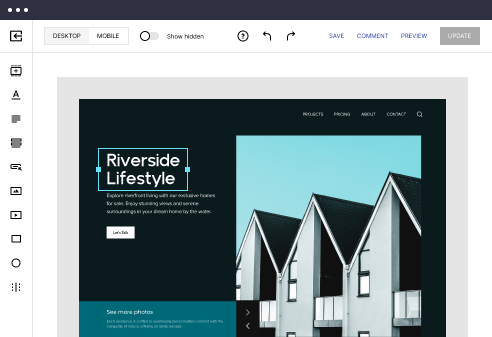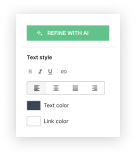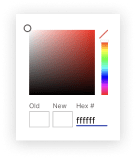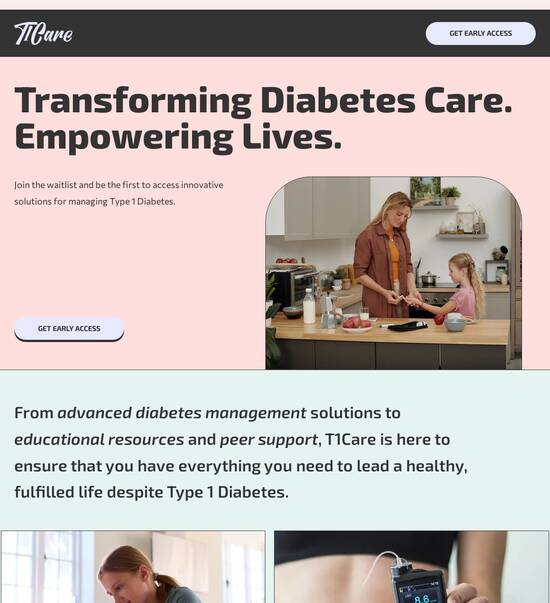
HTML/CSS optimized archive page template
Explore Similar TemplatesAbout template
Supercharge your archive page with HTML/CSS for outstanding performance! Learn more today.
Recommended templates
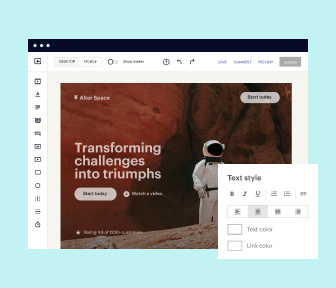
Easy to build without coding
With the intuitive drag-and-drop builder, anyone on your team can create high-converting pages without any knowledge of code or design. Make enhancements to your landing page with custom widgets using Javascript, HTML/CSS, or third-party scripts.
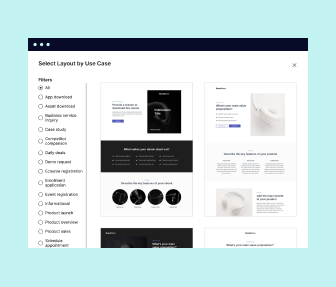
Multiple layouts for any industry and goal
Select from 500+ landing page layouts built to boost conversions across industry-specific scenarios. Customize them by adjusting fonts, adding images, and generating on-brand content with the AI assistant. Quickly scale with Instablocks® and Global Blocks that you can save, reuse, and update globally.
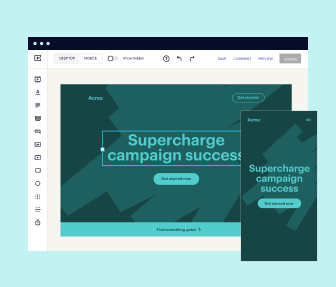
Loads fast and looks polished on any device
Every template is responsive, which means they present professionally on any device and load blazingly fast with our Thor Render Engine. You can also power them up with Google AMP technology to deliver an unparalleled mobile experience and drive higher conversions.
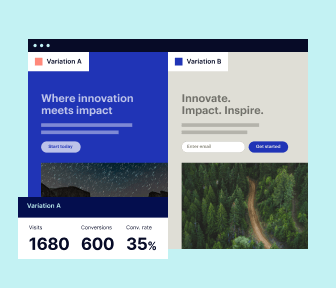
Robust analytics & experimentation
Get real-time updates and reporting across all your devices, showing the number of visitors, conversions, cost-per-visitor, and cost-per-lead. Launch AI-powered experiments, run A/B tests, and use heatmaps to analyze user behavior, then optimize your landing page to maximize conversions.

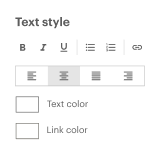
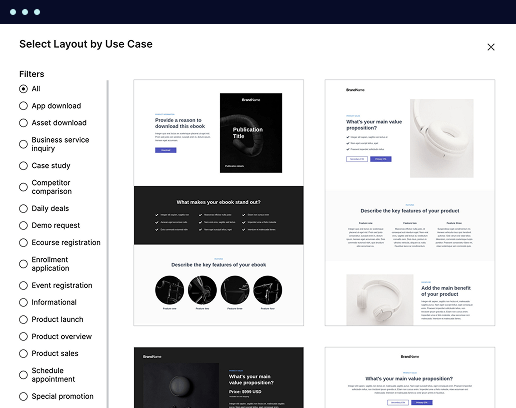
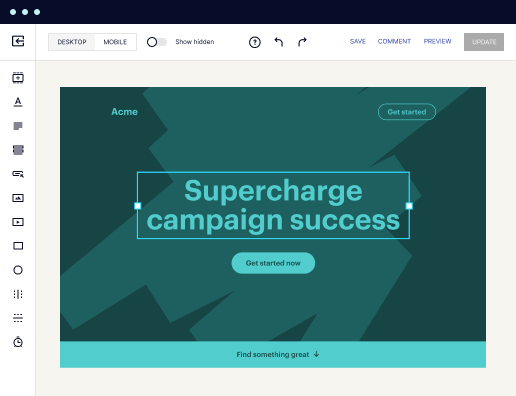
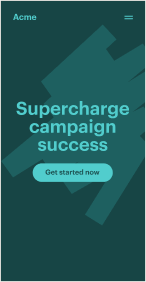
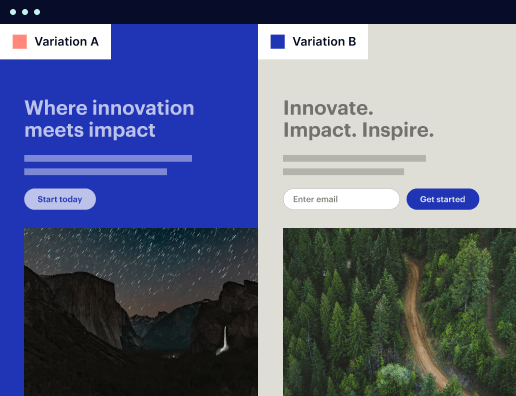

Easy to build without coding
With the intuitive drag-and-drop builder, anyone on your team can create high-converting pages without any knowledge of code or design. Make enhancements to your landing page with custom widgets using Javascript, HTML/CSS, or third-party scripts.
Multiple layouts for any industry and goal
Select from 500+ landing page layouts built to boost conversions across industry-specific scenarios. Customize them by adjusting fonts, adding images, and generating on-brand content with the AI assistant. Quickly scale with Instablocks® and Global Blocks that you can save, reuse, and update globally.
Loads fast and looks polished on any device
Every template is responsive, which means they present professionally on any device and load blazingly fast with our Thor Render Engine.
Robust analytics & experimentation
Get real-time updates and reporting across all your devices, showing the number of visitors, conversions, cost-per-visitor, and cost-per-lead. Launch AI-powered experiments, run A/B tests, and use heatmaps to analyze user behavior, then optimize your landing page to maximize conversions.
All the features you need to build lead-generating landing pages
Explore more featuresLearn how to build top-performing landing pages for any goal
FAQs
Leading the way in building high-performing landing pages





A comprehensive guide to leveraging Instapage for your landing page and CRO strategy
When it comes to maximizing the effectiveness of your digital marketing campaigns, Instapage stands out as a robust landing page and conversion rate optimization (CRO) platform tailored for various industries. This guide will walk you through the essential steps to effectively utilize Instapage, ensuring you optimize your campaigns for maximum ROI.
Understanding key features of Instapage
Instapage provides marketers with an expansive suite of tools including a vast library of high-converting templates, advanced page-building features, and powerful analytics. These tools facilitate the rapid deployment of landing pages tailored to specific campaigns without the need for coding expertise, making it accessible for teams of all sizes.
- 100+ high-converting templates: Choose from a range of designs optimized for various industries to launch your campaigns quickly.
- Intuitive drag-and-drop builder: Edit your pages effortlessly without any technical skills, accelerating your deployment process.
- Built-in A/B testing: Experiment with different elements of your landing pages to discover what resonates most with your audience.
Steps to create your landing page
Creating an effective landing page requires attention to both design and functionality. Follow these steps to develop your page on Instapage:
- Select a template: Begin by choosing a template that matches your campaign's goals.
- Customize your design: Use the drag-and-drop editor to alter text, images, and layout to fit your brand style.
- Set up tracking: Ensure your page is linked with analytics tools to monitor performance post-launch.
Optimizing for conversions
Once your landing page is live, continuous optimization is key to achieving higher conversion rates. Consider these techniques:
- Implement personalized content: Utilize dynamic text replacement to customize messages based on visitor demographics.
- Conduct A/B tests: Regularly test variations of your landing page to optimize elements like headlines and CTAs.
- Analyze visitor behavior: Use heatmaps to see where users engage most and adjust your design accordingly.
With these practices, you can enhance your landing page effectiveness. Always look for new data and feedback to refine your campaigns.
In conclusion, leveraging Instapage can significantly enhance your marketing efforts by simplifying the process of creating high-quality landing pages and enabling effective optimizations.
Ready to elevate your digital campaigns? Sign up for Instapage today and start building your effective landing pages in minutes.
People also ask about HTML/CSS optimized archive page template
HTML/CSS optimized archive page template: A complete guide
Understanding HTML/CSS optimized archive page templates
An archive page template is a specially designed layout that organizes and presents a collection of content systematically. This type of page serves as a comprehensive index for users, making it easier for them to find specific articles, products, or portfolios. Archive pages are crucial for websites as they not only group related content but also enhance the overall user experience by providing structured access to information.
The importance of an optimized archive page template extends beyond mere aesthetics; it plays a pivotal role in website structure. A well-organized archive page can significantly improve user engagement, encouraging visitors to explore more content, which can lead to lower bounce rates and higher conversion rates. By effectively curating content, these templates offer users both immediate access and a satisfying browsing experience.
Blogs and online magazines typically use archive pages to organize articles by date or category.
E-commerce stores can implement archive pages to showcase product listings, allowing users to filter and sort effectively.
Portfolio websites benefit from archive pages by presenting a collection of works, enabling potential clients to navigate easily.
Core technologies driving HTML/CSS archive templates
The backbone of HTML/CSS optimized archive templates lies in their foundational frameworks. Popular frameworks like Bootstrap and Foundation not only provide a solid structure for building responsive designs but also streamline the development process. These frameworks come equipped with a plethora of pre-designed components, allowing developers to focus more on functionality than on code creation, facilitating speedier project rollouts.
Responsive design is vital in today’s multi-device landscape, ensuring that archive pages look great on desktops, tablets, and smartphones. By seamlessly adapting content to various screen sizes, webmasters can cater to a wider audience, thus enhancing user accessibility and engagement.
Faster load times through optimization techniques like minification of HTML, CSS, and JavaScript files.
SEO advantages stem from well-structured templates that improve website visibility on search engines.
Elements of an optimized archive page template
The header and navigation of an archive page are paramount to user experience. Key components such as the logo, search bar, and menu facilitate easy navigation. Ensuring that these elements are prominently displayed and user-friendly paves the way for a satisfying user journey. The usability of a site is heavily influenced by how easily users can move through its pages; hence, clear navigation can significantly decrease frustration and increase time spent on the site.
A featured content section is essential for highlighting top articles or products. This could involve a selection of the latest posts or popular items, enticing users to explore curated recommendations. A decision between static and dynamic content display will depend on the website’s goals, but ensuring this section stands out visually will capture user attention.
Best practices for thumbnails include using high-resolution images that are optimized for fast loading.
Crafting engaging excerpts is instrumental; they should offer a glimpse of the content to entice further reading.
Pagination and load more options are integral to managing content display on archive pages. Pagination encourages users to explore more content through segmented pages, while load more buttons can offer a more fluid experience. Each method has its pros and cons, and understanding the target audience's preferences is essential for choosing the right approach.
Template hierarchy and customization
Understanding template hierarchy is crucial for effectively utilizing HTML/CSS optimized archive page templates. Parent templates serve as the foundation, while child templates inherit and customize elements specific to their use case. This hierarchy allows for scalability and easier maintenance, as changes made to the parent template can cascade down, providing consistency across similar templates.
Customization options for archive page templates are endless, ranging from aesthetic choices like color schemes and typography to layout styles, such as grids versus lists. A visually appealing design not only enhances user engagement but also reinforces the brand identity. Furthermore, integrating user-generated content, such as comments and reviews, can foster community engagement, adding valuable social proof that influences other users' decisions.
Color schemes should be aligned with branding guidelines for consistency.
Choosing between grid and list layouts depends on the type of content and user preference.
Optimizing for performance and accessibility
Performance optimization is integral to maintaining user interest. Techniques for image optimization can include selecting appropriate file formats and using compression tools to reduce loading times. Implementing lazy loading can further enhance page performance, as it ensures only the content that is visible to the user loads initially, reducing unnecessary data usage.
Ensuring compliance with accessibility standards is essential in creating inclusive web experiences. The Americans with Disabilities Act (ADA) compliance mandates that websites accommodate users with disabilities, which not only enhances usability for all but can protect businesses legally. Utilizing ARIA roles and semantic HTML elements assists in making content understandable for assistive technologies, thereby enhancing accessibility.
Using formats like WebP for images can significantly reduce file sizes.
Implementing ARIA roles enhances navigation for users relying on screen readers.
The role of case studies and community feedback
Analyzing successful implementations of archive page templates offers valuable insights into what works and what doesn’t. A review of high-performing websites reveals key metrics, such as increased page views, lower bounce rates, and higher user engagement levels. These metrics can guide webmasters in refining their templates and designs to better meet user needs.
Community feedback from developer forums and social media platforms also plays a critical role in assessing best practices. Engaging with experienced developers can yield actionable advice and innovative ideas, ultimately enhancing the quality of archive page templates and web designs.
High-performing websites often showcase strong visual hierarchies that direct user attention.
Community insights can reveal common pitfalls to avoid in template design.
Future trends in HTML/CSS archive page design
Emerging technologies are reshaping how archive pages are designed and optimized. Artificial intelligence can provide insights into user behavior and preferences, allowing for more personalized content experiences. Such advancements can make dynamic content delivery a reality, adapting in real time to user interactions, thus enhancing the utility and enjoyment of archive pages.
Additionally, CSS Grid and Flexbox continue to gain traction as effective layout solutions. These CSS technologies facilitate more complex and responsive designs while reducing the amount of code needed, making it easier for developers to create visually compelling and functional archive pages.
Emerging design principles will prioritize mobile-first design and high-level accessibility.
Continuous integration of user feedback will drive template evolution.
Collaborative work and team dynamics in template development
Creating effective HTML/CSS optimized archive page templates often involves cross-functional teams that merge expertise from various disciplines. Collaborating with designers and developers ensures that both aesthetic and functional aspects are well integrated into the final product. This collaboration reinforces the importance of cross-team communication, which can boost productivity and lead to more cohesive design decisions.
Workshops and collectives can stimulate innovation and facilitate shared learning. These settings provide opportunities for team members to share best practices and engage in collective problem solving, ultimately enhancing the development process through increased creativity and collaboration.
Regular check-ins and collaborative tools enhance the efficiency of cross-functional communication.
Workshops promote not only technical skills but also team bonding.
Previews and testing methods
Live previews during development play a fundamental role in achieving effective designs. They allow designers and developers to gather real-time feedback, ensuring that user experience aligns with intended design goals. Utilizing tools that simulate user interactions can help identify usability issues before the template goes live, thereby minimizing post-launch revisions.
A/B testing is another critical aspect of template optimization. It allows teams to iterate on designs by comparing two variations to see which performs better in terms of user engagement and conversion metrics. Understanding what to test—ranging from layout and functionality to content style—will enable continuous improvement of the archive page.
Testing various layouts can illuminated which formats users prefer.
Analyzing A/B test results helps to make data-driven decisions for future designs.
Options for further learning and community engagement
Continuous learning in HTML/CSS development is vital for staying updated with industry trends. Numerous platforms offer online courses and certifications that cater to different skill levels, helping developers advance their technical abilities. These resources empower marketers, business service professionals, and other verticals to create high-quality archive pages that enhance user engagement and meet organizational objectives.
Engaging with developer communities is another essential pathway for professional growth. These platforms provide opportunities for networking, where individuals can learn from their peers and share knowledge about effective practices. Platforms such as GitHub and Stack Overflow are invaluable resources for collaborative learning and exchanging ideas.
Online courses in HTML/CSS are available on platforms like Coursera and Udemy.
Participating in local meetups or virtual webinars aids in expanding professional networks.
Conclusion: The transformative power of well-designed archive pages
An optimized archive page template can drastically impact website performance and user engagement. By employing best practices in design, layout, and user experience, these templates can significantly lower bounce rates while boosting time on site, effectively driving conversions. As web technologies continue to evolve, the vision for future website development will likely prioritize user engagement, accessibility, and seamless browsing experiences.
The journey of mastering archive page templates is one of continuous improvement. By implementing learned strategies and integrating user feedback, marketers and developers collaboratively craft web experiences that resonate with their audiences, fostering loyalty and trust.
Ready to skyrocket conversions?
Supercharge your ad campaigns with high-performing landing pages
Get started